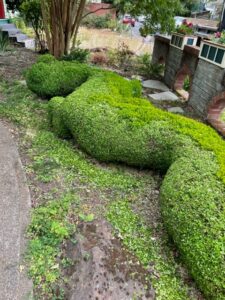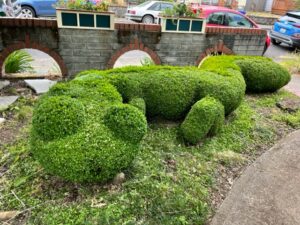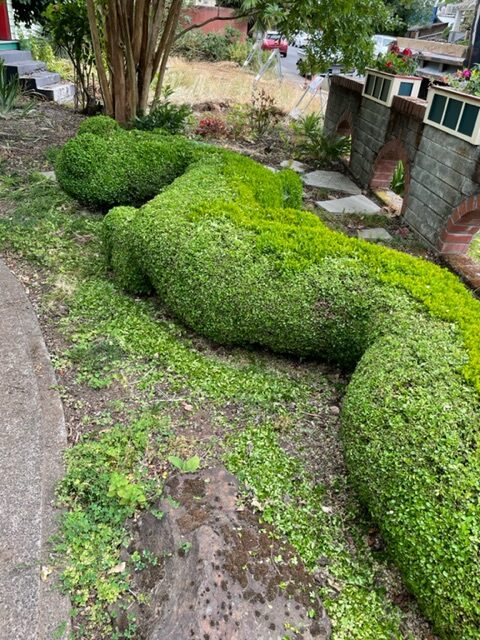 I don’t know if length is more important than girth. It’s a matter of opinion. But it’s something I need to think about because somebody is about to get a little trim.
I don’t know if length is more important than girth. It’s a matter of opinion. But it’s something I need to think about because somebody is about to get a little trim.
In this case, we’re mostly worried about girth. There’s such a thing as being too thick. That’s my opinion. And this whole issue comes up every year because the sucker keeps getting a little woody.
Presumably once my boxwood salamander had its fundamental shape under control it should have been a matter of just maintaining him, but as most of us know that gets harder and harder as the years go on. Once a svelte eft of sorts, my salamander has matured into a real fatty. This is concerning. Just this year I offed my frog when she got too fat to be recognizable. Now, I have seen fat frogs before. In fact, if you’re in the business of ferrying frogs across a highway to their mandatory nuptial zone in a swamp, you’ve hefted quite a few plumpsters. The cool thing about those large, wide females, at least from a human point of view, is that you dump them in the swamp, a bunch of skinny little males clamber over each other to get to her, someone squeezes out her eggs, and she hops back uphill like a kid, except with stretch-marks.
Settle down, millennials, I am not fat-shaming my shrubbery. It’s just that once your frog’s front leg starts to disappear into its belly like Mitch McConnell’s chin into his neck, you no longer know what you’re dealing with. People are liable to point at it and say “What is that? A pastry?”

Half trimmed.
So my salamander has gone from a slender Plethodon to a big-headed Ambystoma to some sort of snot otter and at this point I’m just trying to keep him out of manatee territory.
My salamander gets a little trim only once a year. In the intervening months, he puts on a little wood. I don’t know if you can clip him all the way back to the wood without discouraging him altogether. I don’t want to find out, either. But any more weight around the middle and he’s going to look like a horny-toad and that’s not even an amphibian. And it feels too much like major surgery to really come at it hard. You don’t want to end up in a Michael-Jackson’s-nose situation. Dig too deep, eventually you don’t even have anything to work with.
My botanical buddy is still beautiful, but I’m afraid at some point he is going to be dragging his belly and his little legs are going to be sticking out sideways. And then there’ll be nothing to do but plant four more legs, resculpt the nose, and make a tardigrade out of him.
Although I don’t have any confidence that people would pick up on a tardigrade. Already 90% of passersby stick my salamander in the “hedge” category and overlook him completely. Apparently we’re all so self-absorbed we need our topiary to have four sizeable legs, a neck, and horns before we’ll deign to recognize it. Or have it sitting up on its mammalian haunches, like a squirrel. I’d love to be able to pull that off with boxwood, but I’m afraid only yew can make this squirrel seem right.

Murr, I really dig your bush–okay, I’m just not good at innuendo, and we’ve got plenty here already! Seriously, that’s a pretty groovy shrub and for the record, as someone who stands 5’7″ and is stocky from head to toe, I am all about the girth. :^)
Five Seven. A giant in my book.
Yes!! :^)
In my estimation, too much length or too much girth is scary. In my 20s, I had a summer romance with someone who had the smallest one I had ever seen. Before that, they all were pretty much the same. I was shocked, but then I understood why he collected classic Corvettes. It all becomes clear now!
Oh, wait… were talking about topiaries! Never mind! I do very little trimming of my bushes, since I don’t even own a bathing suit, let alone go swimming. Oh, damn! Again, I fall back on innuendo and double entendre. My default setting, I’m afraid. If you have a dirty mind, EVERYTHING amuses.
Mimi, you’re my kinda gal! (“When correctly viewed / Everything is lewd!” — Tom Lehrer)
Mine are self-trimming.
Only Yew.
Clearly a salamander!! What in hells name is wrong with your passerbyers?
It’s a mystery to me. It goes under their radar.
Time takes a toll, but some things get woody while others shrivel and die. As long as we’re speaking of vegetation I am happy your hedge is still viable. Pretty cute too, having seen the pictures.
Thanks. My personal hedge is deciduous. Apparently.
We all put on weight as we age, even shrubbery. He still looks enough like a salamander to me. I have no idea what a Tardigrade is though.
You must, must, must look up tardigrade. It will improve your life.
I googled so now I recall what a Tardigrade is, I vote for keeping the salamander as long as you possibly can.
Ah! You looked it up. C’mon. Exceedingly cute critter.
I vote with River… especially since we don’t dare add any boxwood hereabouts. Col. Williamsburg plantings tremble at the blight and so do our Gardeners.
Thanks for the pics of yours!
Why you’re welcome. Working on the box turtle but it will be another few years if it succeeds at all.
Murr, did you arrange for email notifications of your blog’s arrival to be sent to yourself too so you can see what they look like? In case you did not, at the bottom of the email were these (two of them truncated, as I saw them):
Breaking — Could Biden Order Americans to Turn i…
Overlooked Message in Bible Americans Want Banned
Rachel Ray Drops Bombshell on Live TV
Thoughts and Prayers Go Out to Dr. Phil
1 Trick “Erases” Wrinkles and Eye Bags Like Crazy (Now Available in Every St…)
Oh, man! This is SO not Murr! Dr. Phil? Bible Americans? I don’t get these e-mails, as i know that she posts on Wednesdays and Saturdays, and just check, as I have her bookmarked. And, in any case, I have AdBlock, so I don’t get ads anyway. But jeeze… talk about not knowing your audience….
You know? I was getting those notifications, but now that I think of it, it’s been a long time. I just resubscribed so I could see. From what I remember I just got an email with a snippet and a “read more” clickable item. Certainly nothing else. We’ll see.
My ads are for Dr Phil, tinnitus relief and two about Biden retiring US currency or some such. ( not clicken on them)
I seldom see ads anywhere. I have AdBlock on my computer. I don’t subscribe to magazines. I don’t have cable or satellite TV (just streaming from Netflix and DVDs.) They do have them in our newspapers, but I manage to somehow ignore them just as I do anything that will depress me too much in print. When Paul and i go out to dinner on date night, we like to sit at the bar so we can talk to strangers. Inevitably, they have a TV. THEN I see ads, and I think OMG, how do people deal with all this shit? And then there are the scrolls! As if there isn’t ENOUGH stuff going on, they have a scroll, sometimes other stuff off to the side…. I just want someone comforting — like Walter Cronkite — to sit me down, take my hands in his, and sigh, “Look. It’s bad. Have a stiff drink… oh, I see you already have one… good…. Let me tell you about the shitshow that is going on. And that’s the way it is….”
Checkout the topiary at Glenstone
Tardigrade a/k/a “moss piglet” — how wonderful is that! And very cute